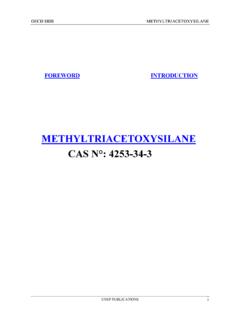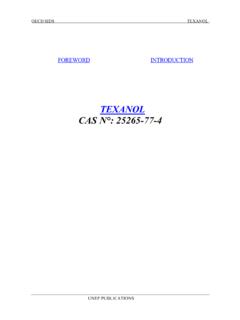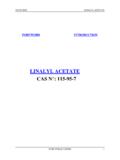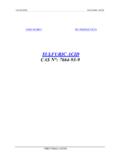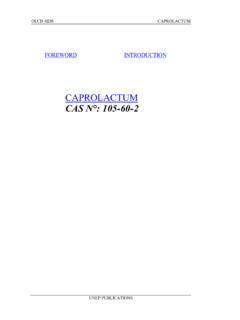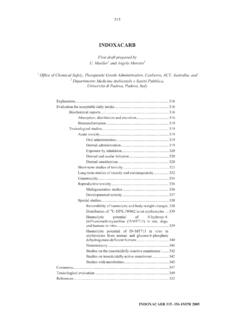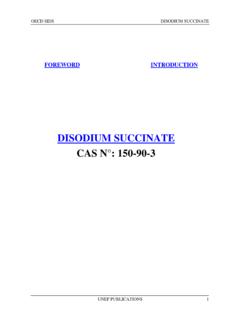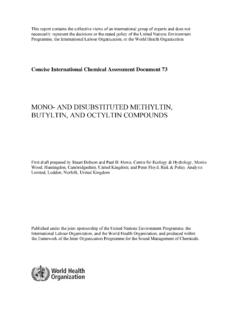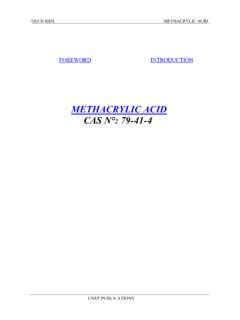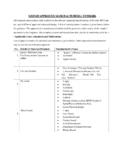Transcription of 3-AMINOPROPYLTRIETHOXYSILANE CAS N°:919-30-2
1 OECD SIDS 3-AMINOPROPYLTRIETHOXYSILANE (APTES). FOREWORD INTRODUCTION. 3-AMINOPROPYLTRIETHOXYSILANE . CAS N :919-30-2. UNEP PUBLICATIONS 1. OECD SIDS 3-AMINOPROPYLTRIETHOXYSILANE (APTES). SIDS Initial Assessment Report For SIAM 17. Arona, Italy, 11-14 November 2003. 1. Chemical Name: 3-AMINOPROPYLTRIETHOXYSILANE 2. CAS Number: 919-30-2. 3. Sponsor Country: United States Oscar Hernandez Director, Risk Assessment Division (7403M). Environmental Protection Agency 1200 Pennsylvania Ave, Washington, DC 20460. Phone: 202-564-7641.
2 Email: 4. Shared Partnership with: Silicones Environmental Health and Safety Council (SEHSC): Clariant LSM (Florida), Inc. Degussa Corporation Dow Corning Corporation GE Silicones Rhodia Inc. Shin-Etsu Silicones of America Wacker Silicones, A Division of Wacker Chemical Corporation 5. Roles/Responsibilities of the Partners: x Name of industry sponsor Silicones Environmental Health and Safety Council /consortium Contact point: Derek Swick SEHSC. 703-904-4322. x Process used The SEHSC produced the documents; EPA reviewed the documents and provided additional information where there were data gaps.
3 2 UNEP PUBLICATIONS. OECD SIDS 3-AMINOPROPYLTRIETHOXYSILANE (APTES). 6. Sponsorship History x How was the chemical or Documents were prepared and reviewed by industry prior to category brought into the submission to sponsor country. Sponsor country conducted OECD HPV Chemicals reviews of submitted data and offered comments to industry. Programme ? Industry prepared and resubmitted documents for consideration at SIAM 17. no testing (X). testing ( ). 7. Review Process Prior to The EPA reviewed this case. the SIAM: 8.
4 Quality check process: Literature searches were conducted by sponsor country to determine if all relevant data have been included in this submission. 9. Date of Submission: August 2003. 10. Comments: UNEP PUBLICATIONS 3. OECD SIDS 3-AMINOPROPYLTRIETHOXYSILANE (APTES). SIDS INITIAL ASSESSMENT PROFILE. CAS No. 919-30-2. Chemical Name 3-AMINOPROPYLTRIETHOXYSILANE [APTES]. O. O. Structural Formula O. Si H2N. SUMMARY CONCLUSIONS OF THE SIAR. Human Health 3-AMINOPROPYLTRIETHOXYSILANE (APTES) has been tested for acute toxicity by the oral, dermal, and inhalation routes of exposure.
5 Acute oral LD50s in rats range from 1570 to 3650 mg/kg bw. The dermal LD50 is g/kg bw and the 4-hour inhalation LC50 of the hydrolysate is greater than mg/L. Six hours of exposure to substantially saturated vapor of APTES did not kill any of the 5 male or female rats (LT50 > 6 hours). The kidney is a target organ for toxicity for oral and dermal exposures. APTES is severely irritating to the skin and eyes. In a Buehler study in guinea pigs, 7/30 animals showed a skin sensitization response. The hydrolysis products of this material do not elicit a sensitization response in a guinea pig maximization test.
6 Repeated inhalation exposure of rats to 147 mg/m3 of APTES hydrolysate respirable aerosol for four weeks produced squamous metaplasia and foci of minimal granulomatous laryngitis. No systemic toxicity was observed in rabbits after 9 repeated dermal doses of 17 or 84 mg/kg bw/day or three repeated dermal doses of 126 mg/kg bw/day of APTES; the site of contact NOAEL is less than 17 mg/kg bw/day. The no-observed-adverse-effect level (NOAEL) of APTES in a 90-day oral (gavage) study with rats was 200 mg/kg bw/day.
7 APTES has been tested in several bacterial reverse mutation/Ames assays, in vitro V79 hamster lung cell and Chinese hamster fibroblast chromosome aberration assays, two Chinese hamster ovary cell HGPRT gene mutation assays, and an in vivo mouse micronucleus assay. In vivo and in vitro screening assays have not revealed any evidence of genotoxic potential. At the highest dose-level (600 mg/kg/day) in a 90 day oral gavage study in rats, no effects were seen on parameters of oestrus cycle and spermatogenesis or reproductive organs.
8 The NOAEL for developmental effects has been identified for APTES following exposure via oral (gavage) in rats, with a value of 100 mg/kg bw/day, the NOAEL. for maternal toxicity based on deaths and ulceration of the GI tract is < mL/kg. Environment The estimated partition coefficient Log Kow is and the estimated water solubility is mg/l; these values may not be applicable because the material is hydrolytically unstable. The vapor pressure is hPa at 20 oC, the melting point is -70 oC, and the boiling point is 223 C at 1013 hPa.
9 Photodegradation modeling indicates the half- life in the atmosphere due to the reaction with photochemically induced OH radicals to be approximately hours. However, photodegradation as a mode of removal is unlikely and not expected to be a significant degradation process because APTES is hydrolytically unstable. APTES is hydrolytically unstable (t1/2 < 1 hour) over a range of environmentally relevant pH and temperature 4 UNEP PUBLICATIONS. OECD SIDS 3-AMINOPROPYLTRIETHOXYSILANE (APTES). conditions, with the exception of pH 7 at 10 or oC.
10 At pH 7, the half-life is 56 or hours, for 10 or oC, respectively. Rapid hydrolysis of this material produces ethanol and trisilanols. The Si-C bond will not further hydrolyze. That bond is hydrolytically stable and the aminopropyl group will not be cleaved. Only the ethoxy groups 4 K 1. 1. will be hydrolyzed. The transient silanol groups will condense with other silanols to yield: 4. 1. 5. %. * . %. * . %. * . 0. *. 4.. G. K. V. J. G. T.. *.. Q. T.. 5. K. %. * . %. * . %. * . 0. * . 1. 4.. 4. *. [. F. T.]
